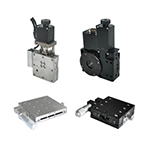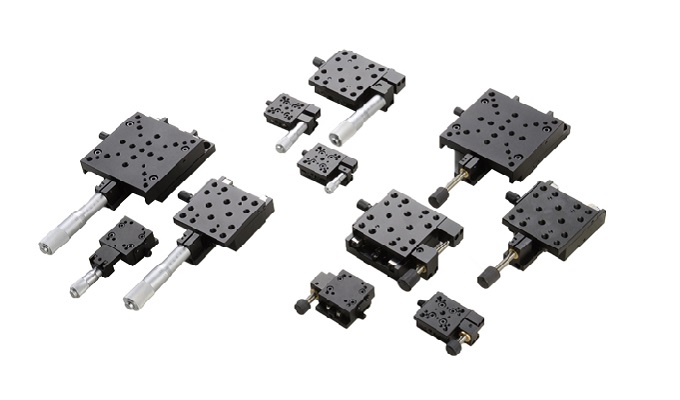Introduction
A manual positioning stage is a commonly used precision measurement device that enables precise measurement and positioning in optics, mechanics, and electronics fields. A movable platform and one or more support brackets allow manual control of the platform's horizontal or vertical movement to achieve the desired displacement and accuracy. It finds applications in various precision measurement and positioning fields, including optical microscopy, laser cutting machines, semiconductor production, mechanical manufacturing, and automated assembly. In these applications, manual positioning stages are used for positioning and measuring samples, devices, or components to facilitate precise processing, testing, or assembly.
Key Considerations for Choosing a manual positioning stage:
Load Capacity:
Load capacity is a fundamental factor when selecting a manual displacement stage. It determines the maximum weight the stage can bear and affects measurement precision and stability.
Once your application's maximum load requirement is determined, choosing a manual linear stage with sufficient load capacity is crucial. The load capacity of a manual linear stage is typically specified in its datasheet. As a general guideline, the stage's load capacity should slightly exceed the maximum load required to ensure safe operation and provide an adequate margin for different usage scenarios.
The stage's structure and materials can also impact its load capacity. Some manual linear stages utilize aluminum alloy or steel frames to enhance load capacity. In contrast, others employ high-strength plastics or carbon fiber composites to balance lightweight design and load capacity.
It is important to note that a higher load capacity is not always better. Opting for a manual linear stage with excessively high load capacity may result in higher costs and increased operational complexity. Therefore, when selecting a manual linear stage, it is essential to strike a balance between price, operational ease, and load capacity based on the maximum load requirement of your application.
Accuracy and Resolution:
The accuracy and resolution of a manual linear stage are crucial performance indicators that directly impact the precision of measurements and positioning. Therefore, careful attention must be paid to its accuracy and resolution when selecting a manual positioning stage.
Accuracy refers to the displacement precision that a manual linear stage can achieve and is typically expressed in millimeters or micrometers. The accuracy of a manual positioning stage is influenced by various factors, such as its mechanical structure, materials, manufacturing processes, and more. For instance, high-precision manual positioning stages often employ ball screws, precision guides, and advanced manufacturing techniques like CNC machining and automated assembly to achieve higher levels of accuracy.
On the other hand, the resolution refers to the smallest detectable displacement that the manual positioning stage can resolve and is usually measured in micrometers or nanometers. The resolution of a manual positioning stage is determined by the design of its measurement system, including sensors, readouts, and other components. High-end manual stages may incorporate high-precision measurement systems like laser interferometers to achieve higher resolution.
When selecting a manual positioning stage, it is essential to determine the required level of accuracy and resolution based on your application needs. Generally, fields such as scientific research and high-precision manufacturing demand higher levels of accuracy and resolution, while more general measurement and positioning tasks may tolerate lower levels. It is important to note that the accuracy and resolution of manual linear stages often influence their price, so a balance between performance and cost needs to be struck.
During the practical use of a manual linear stage, factors such as ambient temperature, humidity, vibrations, and other environmental conditions can affect its accuracy and resolution. Additionally, regular inspections and maintenance should be performed to ensure that the manual linear stage maintains its expected level of performance.

Operational Sensation:
In precision operations, a manual linear stage with a good operational sensation can significantly enhance accuracy and comfort during use. Therefore, when purchasing a manual linear stage, evaluating its operational sensation is crucial to ensure it meets the practical requirements.
The operational sensation of a manual linear stage primarily encompasses two aspects: motion smoothness and control stability. The design and manufacturing quality of the manual linear stage heavily influences the smoothness and stability. Design-wise, factors such as slide rails, guides, screws, gears, and bearings all impact the smoothness and stability of the manual linear stage. Regarding manufacturing, processing techniques, surface finish, and component fit accuracy also affect the operational sensation.
Also, we need to consider these ways:
① Attention should be given to the design of the manual displacement stage. The design should aim to minimize friction and reduce resistance during motion. Additionally, the center of gravity and counterbalance of the manual linear stage should be considered to ensure balance and stability during operation.
② The manufacturing quality of the manual linear stage is important. High-precision manufacturing techniques should be employed, and fit accuracy between components should be ensured. Furthermore, surface finish plays a significant role in the operational sensation. Higher surface smoothness leads to better operational sensation and smoother operation.
③ Maintenance and upkeep of the manual linear stage should be considered. Following the instructions in the user manual for regular cleaning, lubrication, and inspection will ensure consistent operational sensation of the manual linear stage.
By considering the design, manufacturing quality, and maintenance of the manual linear stage, one can select a manual linear stage that offers a smooth and easily controllable operational sensation, thus improving accuracy and user comfort.
Size and Dimensions
The size and dimensions of a manual linear stage must be compatible with the spatial requirements of the application to ensure that the equipment can fit within the actual operating environment. Firstly, determining the spatial requirements of the application is crucial in selecting an appropriately sized manual linear stage. Sufficient space is needed to accommodate the entire equipment during measurements and positioning. Therefore, when considering the physical dimensions of the equipment, it is essential to consider the actual conditions of the operating environment. For instance, if the manual linear stage is intended for research and experimental work, a larger space may be required to accommodate the experimental setup and other equipment. On the other hand, if the manual linear stage is used in a production line, smaller dimensions may be necessary to fit within a confined operating space.
Secondly, the manual linear stage's weight should also be considered. Generally, the weight of a manual linear stage is related to its size and load capacity. Therefore, when choosing a manual linear stage, it is important to ensure that its weight suits the operating environment. If the equipment is too heavy, additional support structures may be required to ensure stability, increasing the difficulty and cost of usage and maintenance.

Materials and Durability
Different materials used in manual positioning stages have varying strengths, durability, and maintenance costs. Therefore, understanding the relationship between materials and durability is essential when selecting a suitable manual positioning stage.
Types of Materials
Manual displacement tables are typically made from metals, plastics, and composite materials. The most common metals used are aluminum alloys and stainless steel. Aluminum alloys are lightweight and cost-effective but have lower corrosion resistance. On the other hand, stainless steel is relatively heavier and more expensive but offers excellent corrosion resistance. Plastics are commonly used for the structural components of manual linear stages. They possess good toughness and vibration resistance but are unsuitable for bearing heavy loads. Composite materials, which consist of a combination of different materials, can provide higher strength and rigidity but come at a higher price.
Durability
The durability of a manual positioning stage refers to its ability to maintain stability under different environmental and operating conditions. A high-quality manual linear stage should withstand significant loads and frequent movements while exhibiting good corrosion resistance. Different materials can affect the durability of the manual linear stage. For example, aluminum alloy manual linear stages are prone to rusting after extended use, while stainless steel manual linear stages offer superior corrosion resistance.
Users can ensure that it meets their specific applications' spatial requirements and durability needs by considering the appropriate size, dimensions, and materials for the manual linear stage. It will contribute to the optimal performance and longevity of the equipment.
Maintenance Cost
The maintenance cost of a manual linear stage includes repairs, cleaning, and replacement of components. The choice of materials can also impact the maintenance cost. For example, aluminum alloy manual linear stages require more frequent cleaning and maintenance, while stainless steel manual linear stages require less maintenance.
Price
The price of a manual linear stage varies based on factors such as performance, quality, size, materials, brand, etc., ranging from a few hundred to several thousand dollars. Therefore, it is important to select a manual linear stage with a reasonable price based on the application requirements and experimental needs.
① It is recommended to conduct market research and comparisons to better understand the prices of different models of manual linear stages available in the market. The prices of the same model of the manual linear stage can also vary among different suppliers and brands. Therefore, when selecting a manual linear stage, comparing the prices and differences in performance and quality among different brands and suppliers is necessary to find the best value for money.
② The selection of a manual linear stage should be based on the application requirements and experimental needs. For example, if precise positioning of small loads is needed, a lower-priced manual linear stage may be suitable. In contrast, a higher-priced manual linear stage may be necessary for high-precision positioning of larger loads. Therefore, when choosing a manual linear stage, it is important to balance the application requirements, experimental needs, performance, and price to find the most suitable option.
Additionally, the lifespan and maintenance costs of the manual linear stage should be considered. Although lower-priced manual linear stages may appear more cost-effective, if their quality and lifespan are inferior to higher-priced ones, they may require more repairs and maintenance, thus increasing the overall cost. Therefore, when selecting a manual linear stage, it is important to consider the maintenance costs and lifespan to find the most suitable option for the application requirements and experimental needs.
When choosing a manual linear stage, multiple factors need to be considered:
The maximum load should be determined based on the application requirements, and a manual linear stage with sufficient load capacity should be selected.
The accuracy and resolution requirements of the application should be determined, and a manual linear stage with appropriate accuracy and resolution should be chosen.
The operational feel is an important consideration, and a manual linear stage with smooth and easy control should be selected. Size and dimensions are other factors to consider, and a manual linear stage of appropriate size should be chosen to meet the spatial requirements of the application. Material and durability are also important factors to consider, and a manual linear stage with high-quality materials and good durability should be chosen.
Price is a factor that needs to be considered, and a manual linear stage with a reasonable price should be selected based on the application requirements and experimental needs.





